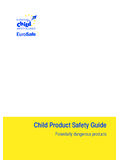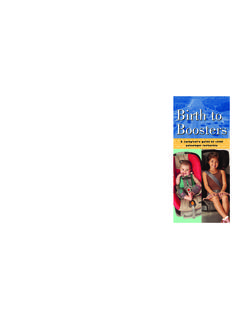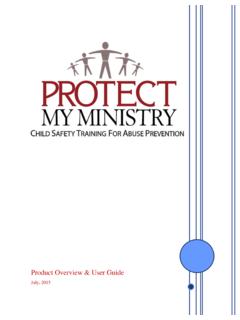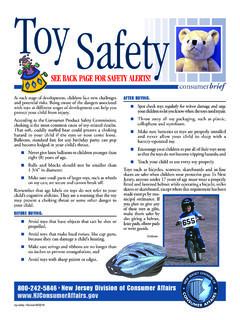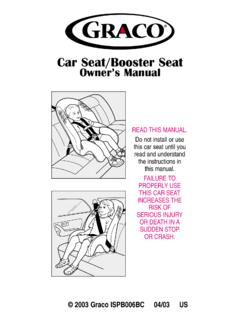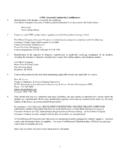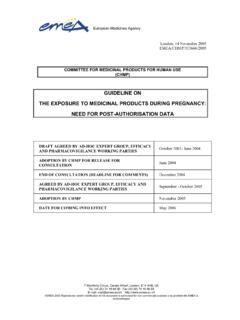Transcription of and support of the European Commission
1 European child safety AlliancePO Box 751691070 AD AmsterdamThe NetherlandsTelephone +31 20 511 4500 Fax +31 20 511 partnership withand support of the European CommissionEUROPEANCONSUMERSAFETYASSOCIAT IONP02 0847 DVLto child safety Regulations andStandardsin EuropeA GuideEUROPEANCONSUMERSAFETYASSOCIATIONP0 2 0847 DVLA guide TO child safety REGULATIONS AND STANDARDS IN EUROPE1A guide to child safety Regulations and Standards in EuropeEuropean child safety AlliancePO Box 751691070 AD AmsterdamThe NetherlandsTelephone +31 20 511 4500 Fax +31 20 511 or parts of the text maybe copied, provided that reference is made to the title of the publication andaddress of the publisher.
2 ISBN: 90-6788-288-7 March 2003 EUROPEANCONSUMERSAFETYASSOCIATIONI ntroduction 3 Roles of European and national regulation 4 The relevance of European Union regulations 5 The European regulator y process 6 The role of standards 7 Quality of standards 8 The European standardisation process10 Enforcement of regulations 12 Review of regulations, standards and best practice 13 Summar y and recommendations 37 References 39 Sources of further information 40 List of abbreviations 42 Glossar y 43 Contact information45A guide TO child safety REGULATIONS AND STANDARDS IN EUROPE2 Table of contentsRegulation is an important element in child safety acci-dent prevention.
3 Many successful injur y prevention inter-ventions directly involve or are dependent on regulationsand standards. Regulations can influence behaviour,products or the environment within which children findthemselves. Reduced speed limits, the adoption of childresistant designs for cigarette lighters, the compulsor yuse of child resistant packaging for all children s aspirinand paracetamol preparations, to give but a few exam-ples, are all regulator y initiatives that have resulted insignificant reductions in accidents involving children. However what does this mean for us in the changingEurope we live in. With the expansion of the EuropeanUnion we are seeing that national jurisdiction over regu-lation is being replaced in many fields with a sharedresponsibility between national and European authori-ties, and the spread of the EU eastwards.
4 This guide tries to present and clarify the role of regulation in child accident prevention in today s Europe. The different aspects of the regulator y process areexamined and a state of the art review of the standardsand regulations currently in existence is presented. This review identifies not only the existing European regulations and standards but also identifies best practice where this doesn t exist at the European levelbut rather at the national level. On the basis of thisover view a number of priorities for action are is a general introduction to the ver y complicatedregulator y process. There is however a list of sourcesfor further information that deal in much greater detailwith specific aspects of the regulator y process.
5 The regulator y process described in this guide is not per-fect, neither is the standardisation process that is exten-sively relied upon by the regulator. There are also legiti-mate concerns over the enforcement of the regulationsand standards that do exist. Some of the limitations ofthe current set-up are acknowledged in this it is not the intent of the guide to provide anextensive critique of the existing arrangements or topresent recommendations for their improvement. For amore extensive critique of the regulator y process and forrecommendations for its improvement the reader isdirected to the report published last year by ECOSA,"Priorities for Consumer safety in the European Union:Agenda for Action".
6 Lastly, we should also note that many aspects of theregulator y process are in a state of change. The imple-mentation of the revised General product SafetyDirective over the coming years will have a considerableimpact on many aspects of the regulator y notably there will be important changes to the useof standards and in the arrangements for the co-ordination of enforcement and regulator y action atthe European level. A guide TO child safety REGULATIONS AND STANDARDS IN EUROPE3 Introduction The Member States of the European Union have agreedto allow the Union to act in many different policy most important is the regulation of the so-called sin-gle market.
7 Within the single market, also called theinternal market, products and ser vices can be tradedfreely between the Member States. Regulations andstandards that var y from one countr y to the other canhinder this free flow of goods and ser vices. In an effortto avoid this happening, the Member States of the EUhave given the European Commission the responsibilityto lay down regulations affecting the cross-border tradein products. These laws generally have to be implement-ed by the Member States. In effect these laws deter-mine the level of pro-duct safety throughout theEuropean Union. The European Union has also been given the power bythe Member States to take initiatives to promote consumer protection and public health.
8 Recent amend-ments to the Treaty establishing the EU have specificallyidentified a role for the EU to play in promoting con-sumer protection and public health. This developmentacknowledges the coordinating role that the EU can playto assist the Member States in tr ying to protect theirconsumers and care for the health of their public. Member States are free to regulate when the EuropeanUnion does not. Member States alone have the respon-sibility to regulate their day-care, schools, sports instal-lations, playgrounds, swimming pools and building regu-lations. Member States can also exceed the provisionslaid down in European laws and establish a higher levelof product safety (for example removal of drawstrings inchildren s clothing UK, children are rear ward facing forlonger in child restraints in cars in Sweden).
9 However in the case of product regulations that couldaffect trade with other Member States they must be ableto justify why they have had to go further. The ultimate responsibility for child accident preventionalways rests at the national level. Europe however doesplay a number of important roles and we have to look toboth levels when pursuing our objective of reducing guide TO child safety REGULATIONS AND STANDARDS IN EUROPE4 Roles of European and national regulationEuropean RegulationsTake precedence in trade matters (article 95 Treaty of Rome). The European Commission also has the right to propose measures to promote consumer and healthprotection in particular with relation to the coordination of national initiatives (articles 129 and 152 of the Treaty)National RegulationsCan be made where there are no European regulations and can exceed European regulationswhere the national authorities can justify why this is necessar y (Article 36 of the Treaty)Many significant political developments have taken placein Europe especially over the past ten years.
10 There hasbeen the creation of the single market. This has beenextended beyond the European Union Member States tothe European Free Trade Agreement (EFTA) MemberStates, Iceland, Nor way and Liechtenstein, in theEuropean Economic Area. We have also seen the fall ofthe Berlin Wall and the Iron Curtain. This has broughtCentral and Eastern Europe much closer to the West. Infact a number of these countries are now well on theroad towards membership of the European Union andsome are in by 2004. These developments dictate thatwe must now have a broader view in mind when we talkabout Europe. In order to create the single market thefifteen Member States of the European Union have har-monised many of their laws in particular with respect toproducts.
